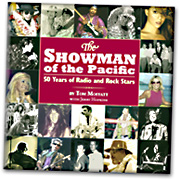COURTESY JOHN DEMELLO
Tom Moffatt still plays rock 'n' roll on the radio, at Oldies 107.9 FM.
|
|
Uncle Tom’s gabbin’
Tom Moffatt opened his archives for the first time in 1998 when he published the aptly titled "Uncle Tom's Rock 'n Roll Scrapbook" in 1998. The scrapbook consisted mostly of hundreds of vintage photos and assorted memorabilia from his decades at the center of Hawaii's entertainment industry. It was a great retrospective, priced to sell and an instant hit.

"The Showman of the Pacific: 50 Years of Radio and Rock Stars"
by Tom Moffatt
with Jerry Hopkins
(Watermark Publishing,
2005, $34.95)
|
|
This book, an expansive autobiography, shares the stories behind the photos and reveals a lot more about the man Hawaii has known for 50 years as "Uncle Tom." It's a must-buy for anyone who grew up back when "Boss Radio K-POI" ruled the airwaves, and an excellent easy-to-read history of the music business in Hawaii during the past half-century.
It opens with a vivid description of a day in the life of Hawaii's top concert promoter -- and a celebrity in his own right (Moffatt doesn't describe himself that way, of course). The day he describes -- breakfast with Jimmy Buffett, business meetings, weighing the probable profit margin and potential appeal of various attractions he could present here -- is a perfect introduction to who he is, what he does and his outlook on life and the entertainment business.
What a life! He starts with his experiences growing up outside Detroit, and continues with a fascinating collection of stories that cover the development of contemporary radio programming in Hawaii, his role as Hawaii's hometown Dick Clark and his experiences -- in talent management, as a record label president, and as concert promoter. The book is a quick and easy read, with Moffatt an engaging and entertaining narrator.
After 50 years in an industry filled with hype and exaggeration, Moffatt's accomplishments speak for themselves. He got into radio when Honolulu had only four stations, played the first rock 'n' roll record on any local station (Bill Haley & The Comets' "Rock Around the Clock" in 1955) and was one of the originators of modern radio programming in Hawaii.
He was one of a small group of radio personalties who were only a few years older than the teenagers who listened to them. He hosted "The Tom Moffatt Show," a local version of Dick Clark's "American Bandstand" on KHVH-TV, and a few years later was part of a group that developed the concept of nationally syndicated radio shows ("American Top 40" was the first).
COURTESY JOHN LAU, CITY ART WORKS
Moffatt interviews the Everly Brothers before a Civic Auditorium performance.
|
|
Moffatt got into concert promotion in the mid-'50s at the invitation of older promoters who needed his knowledge of rock. In the early days, that meant mostly teenage rock and pop acts. Moffatt helped bring almost all of them to Hawaii.
His 1998 book told that story primarily with photos; this time he includes more of the backstage stuff, and shares more information about some of the shows he's presented outside Hawaii.
Moffatt recalls the bad times too: the shows that should have made money but didn't, the period in the 1980s when he lost touch with his audience by playing Menudo too often.
The secret in one line: Stay in touch with your market!
Moffatt gets an assist from veteran rock writer Jerry Hopkins, but it's Moffatt's story from start to finish. For instance, if Hopkins were writing one of his conventional biographies he would certainly have explored the extent to which K-POI and its predecessor, K-POA, shaped the musical preferences of island teens in the '50s and '60s.
TOM MOFFATT COLLECTION
Tom Moffatt interviews Elvis Presley after his 1957 Hawaii debut at Honolulu Stadium.
|
|
Moffatt mentions in passing that Hawaii was an isolated market and that local radio stations had no competition. Hawaii teens heard only what the local Top 40 stations decided to play, and the local stations favored ballads over rock, and white pop over most of the major country and R&B hit makers. Light pop ballads and white pop "cover bands" were uniquely popular in Hawaii for several decades.
On the other hand, we all would have missed out on "I Must Be Dreaming" if Moffatt hadn't felt that Hawaii would enjoy that Neil Sedaka ballad more than the designated "A side" and national hit, "Little Devil."
As might be expected, Moffatt doesn't dish much dirt. He reveals just enough about Country Comfort to show why his experiences with the group convinced him to get out of talent management, but doesn't go into details.
Moffatt does have sharp words about some of the people he's encountered on the corporate side of radio in recent years, from a legitimate standpoint -- as the popularity of his current Saturday-morning radio show makes clear, no one knows more about what Hawaii residents want to hear on an "oldies" station than "Uncle Tom." He's been there from the beginning.

